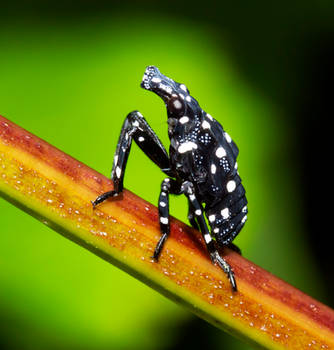ShopDreamUp AI ArtDreamUp
Deviation Actions
Description
Weevil, a tiny beetle that does enormous damage to growing plants and stored grains. There are more than 40,000 known species of weevils. The mouthparts of a typical weevil are formed into a long snout. There is an antenna on each side of the snout. In a number of species, the snout is longer than the body, which seldom grows to half an inch (13 mm) in length.
The snout is used not only for feeding but also for making cavities in which the eggs are laid in buds, fruits, seeds, stems, and roots of plants. When the grubs (larvae) emerge, they feed within the plant parts. Infested fruits fall from the trees, or become stunted, scarred, or wormy, and are generally unfit to eat. Buds and seeds are destroyed by weevils and their larvae, and plants are weakened by their attacks.
The boll weevil is the chief insect pest of cotton. .) The plum curculio attacks plums, peaches, cherries, and apples. The alfalfa weevil is a destructive pest of alfalfa. The rice weevil and the grain weevil feed on stored small grains and lay their eggs within the grains. The acorn weevil feeds on acorns.
A weevil’s snout, or nose, is curved downward so that it can bore into plants. At the end of the long snout are the weevil’s mouth parts that chew fruits, seeds, and other plant parts.
Different kinds of weevils have different kinds of snout shapes. Each shape is adapted to eating certain plants or parts of plants. For example, the female nut weevil’s snout is often longer than its body. It needs a long snout to bore through the hard shell of a nut and to lay its eggs inside.
The boll weevil is Anthonomus grandis; plum curculio, Conotrachelus nenuphar; alfalfa weevil, Hypera postica; grain weevil, Sitophilus granarius; rice weevil, S. oryzae; acorn weevil, Curculio rectus. These weevils are snout beetles, or snout weevils, forming the family Curculionidae of the order Coleoptera. Seed weevils, which are smaller than snout beetles and lack the snout, form the family Bruchidae. The cowpea weevil, Callosobruchus maculatus, is an example.
Source [link]
The snout is used not only for feeding but also for making cavities in which the eggs are laid in buds, fruits, seeds, stems, and roots of plants. When the grubs (larvae) emerge, they feed within the plant parts. Infested fruits fall from the trees, or become stunted, scarred, or wormy, and are generally unfit to eat. Buds and seeds are destroyed by weevils and their larvae, and plants are weakened by their attacks.
The boll weevil is the chief insect pest of cotton. .) The plum curculio attacks plums, peaches, cherries, and apples. The alfalfa weevil is a destructive pest of alfalfa. The rice weevil and the grain weevil feed on stored small grains and lay their eggs within the grains. The acorn weevil feeds on acorns.
A weevil’s snout, or nose, is curved downward so that it can bore into plants. At the end of the long snout are the weevil’s mouth parts that chew fruits, seeds, and other plant parts.
Different kinds of weevils have different kinds of snout shapes. Each shape is adapted to eating certain plants or parts of plants. For example, the female nut weevil’s snout is often longer than its body. It needs a long snout to bore through the hard shell of a nut and to lay its eggs inside.
The boll weevil is Anthonomus grandis; plum curculio, Conotrachelus nenuphar; alfalfa weevil, Hypera postica; grain weevil, Sitophilus granarius; rice weevil, S. oryzae; acorn weevil, Curculio rectus. These weevils are snout beetles, or snout weevils, forming the family Curculionidae of the order Coleoptera. Seed weevils, which are smaller than snout beetles and lack the snout, form the family Bruchidae. The cowpea weevil, Callosobruchus maculatus, is an example.
Source [link]
Image size
960x640px 280.76 KB
© 2012 - 2024 melvynyeo
Comments8
Join the community to add your comment. Already a deviant? Log In
Cool looking weevil!



















![Play with pattern [net winged beetle]](https://images-wixmp-ed30a86b8c4ca887773594c2.wixmp.com/f/c53e7f9a-f10e-484a-b434-a34c52ded0e8/db80g1s-82d2d2c5-446a-4dbb-9f7c-9e1da18a1258.jpg/v1/crop/w_184)














